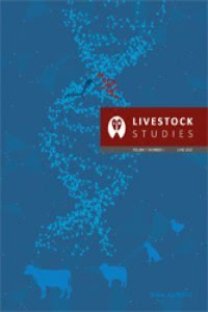ESMER IRK İNEKLERE AİT LAKTASYON EĞRİSİ PARAMETRELERİNİN FARKLI MATEMATİKSEL MODELLERLE TESPİTİ VE BU PARAMETRELERE BAZI ÇEVRESEL FAKTÖRLERİN ETKİSİ
Erzurum Atatürk Üniversitesi Araştırma Çiftliği’nde yetiştirilen Esmer ırkı ineklere ait 718 laktasyon kaydı farklı modellerle incelenerek, laktasyon eğrisi parametrelerine sistematik çevre faktörlerinin etkileri araştırılmıştır. Bu amaçla, gamma fonksiyonunu esas alan Wood Modeli, ters polinomiyal fonksiyon ve indirgenmiş laktasyon persistensi modellerinden yararlanılmıştır. Wood modeliyle elde edilen parametrelerden lnA ya buzağılama yılının etkisi, b’ye buzağılama mevsiminin etkisi, c’ye de laktasyon sırası ve buzağılama mevsiminin etkisi istatistiksel olarak önemli (P<0.05) bulunmutur. Öte yandan, ters polinomiyal fonksiyonla tespit edilen parametrelerden A1’e laktasyon sırası ve buzaılama mevsiminin, A2’ ye ise yalnızca buzaılama mevsiminin etkisi çok önemli (P<0.01) olmutur. ndirgenmi laktasyon persistensi modeli ile belirlenen parametrelerden Yp’ ye laktasyon sırası ve buzaılama yılı, t1 ve b3’ e ise buzaılama yılının çok önemli (P<0.01) etki ettii saptanmıtır. Laktasyon erisi parametreleri bakımından yapılacak bir seleksiyon öncesinde, bu ölçütlere ilikin fenotipik deerlerin etkili olduu belirlenen çevre faktörlerine göre düzeltilmesi gerektii sonucuna varılmıştır
Anahtar Kelimeler:
Esmer inek, laktasyon eğrisi parametreleri, çevresel faktörler
Determination with different mathematical models of lactation curve parameters of Brown Swiss cows and the effects of some environmental factors on these parameters
Data on 718 lactation records pertaining to Brown Swiss cows reared in Research Farm of College of Agriculture at Atatürk University were analyzed to find out the effects of some systematic environmental factors on the parameters of lactation curve obtained from different models. For this purpose, Wood model based on gamma function, inverse polinomial function and reduced lactation persistency models were utilized in this study. The effects of calving year, calving season as well as parity and calving season on the LnA, b, c values obtained from Wood model were significant (P<0.05) respectively. On the other hand, the effects of parity and calving season as well as calving season on A1 and A2 calculated from inverse polinomial function were highly significant (P<0.01) respectively. The effects of parity and calving year on Yp, t1 and the influences of calving year on t and b3 determined from reduced lactation persistency models were highly significant (P<0.01). It was concluded that the phenotypic values must be standardized according to significant environmental factors before a selection regarding with lactation curve parameters
- Yayın Aralığı: Yılda 2 Sayı
- Başlangıç: 1959
- Yayıncı: Sezer ÖZ
